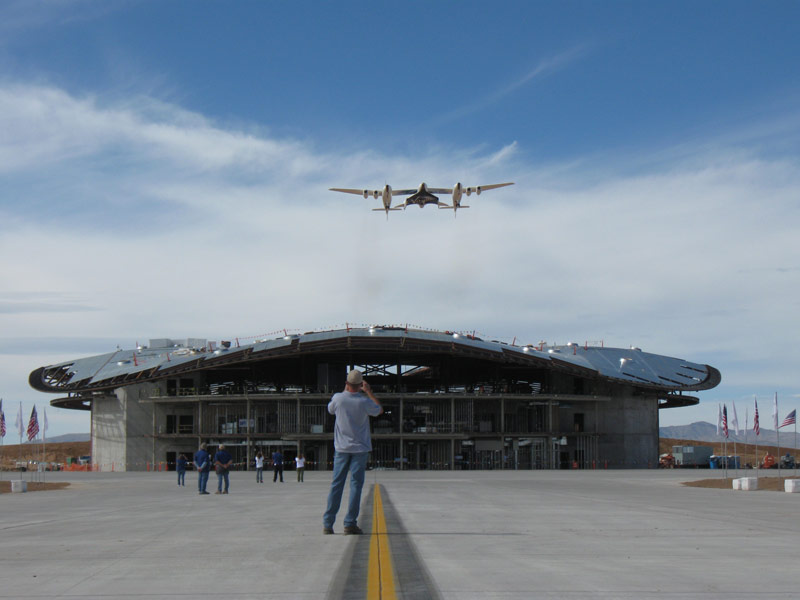N.M. Spaceport Kicks Into High Gear for Commercial Spaceflight

Work on Spaceport America is in full swing, with the state-of-the-art space launch facility near Truth or Consequences, N.M. expected to become fully operational in 2011.
Officials at Spaceport America here have been working closely with their anchor tenant — Virgin Galactic — in the company's quest to provide pay-per-view passenger treks to suborbital space.
Other leading aerospace firms, such as Lockheed Martin, Moog-FTS, Armadillo Aerospace and UP Aerospace, are also moving toward increased use of Spaceport America facilities to push forward on their space ventures.
Completion of milestones
"Spaceport America is pretty close to what we originally envisioned. We're on track," said Rick Homans, executive directorof the New Mexico Spaceport Authority. "You can really feel it now. Time is becoming more concentrated and condensed, and the pressure is building internally to set up operations for the spaceport to anticipate all kinds of issues that may not have been as clear three to four years ago."
While December 2011 was previously projected as the start of commercial operations, Homans said that Virgin Galactic is not going to be held to a timetable. "They are going to be held to successful completion of milestones."
For Spaceport America's part, Homans said, the biggest challenge right now is moving from a construction project to Virgin Galactic's first commercial launch from New Mexico and putting in place policies, procedures and staffing at the $212 million facility.
Breaking space news, the latest updates on rocket launches, skywatching events and more!
Still to come is the installation of welcome centers in nearby counties, a visitor center at Spaceport America, as well as gauging the number of people that are expected to travel to the facilities, Homans said."We do know that this is going to attract a lot of people. What that means, in bright green letters, is opportunity — and it means business development," he said.
Making eye contact
Armadillo Aerospace plans to bring its rocket hardware to Spaceport America to launch different test vehicles, likely between the last quarter of this year and the first quarter of next year, Homans said
"They don't need very much right now. That's the beauty of these companies at the moment. They don't want us to put in a whole lot of infrastructure that they suddenly have to pay for. They want us to keep it very simple and very basic," Homans said.
Armadillo vehicles would fly from already-in-place launchpads, situated approximately six miles from Spaceport America's main structures.
The development at the spaceport, and in other commercial space ventures, is beginning to attract the notice of lawmakers, Homans said.
"There are signs that the federal government is slowly turning its head to take notice of this commercial spaceflight industry. In the years before we had seen no motion, hadn't seen that head turn a centimeter. Now it's almost making eye contact with us," Homans said.
Flying testbeds
Several Armadillo spacecraft are set to begin testing soon at the spaceport, Neil Milburn, vice president of program management at Armadillo Aerospace in Rockwall, Texas told SPACE.com during last month's International Symposium for Personal and Commercial Spaceflight in nearby Las Cruces, N.M.
"We're looking forward to it," Milburn said.One rocket to undergo evaluation is a low-cost alternative for reaching suborbital space with scientific payloads. That vehicle and other hardware will aim to hone the company's ambitions to build a suborbital space tourism vehicle.
"All the stuff we've got are flying testbeds,"Milburn added. Armadillo will also use the Oklahoma Spaceport to flesh out some of their vehicles, he said, but they are restricted to the altitude they can reach there, with higher altitude test shots available at Spaceport America.
On the glide path
Will Whitehorn, president of Virgin Galactic, said: "Everything has come together. Virgin Galactic is now fully-funded through commercial launch. Spaceport America is going to be finished and it looks every bit as good as I thought it was going to look."
Whitehorn said the first solo glide flight of the company's suborbital plane SpaceShipTwo released at high altitude by the WhiteKnightTwo carrier craft on Oct. 10 "flew better than the computer said it was going to fly."
The solo flight by SpaceShipTwo was viewed as a major milestone for Virgin Galactic, Whitehorn said."Designing a vehicle that's capable of being a supersonic aircraft, a spaceplane and a good glider is a real challenge," he emphasized.
"So we are feeling quite proud at the moment. We've got the beginnings of commerciality," Whitehorn added. WhiteKnightTwo has also proven to be a very robust vehicle too.
"There's nothing that I can see in this program at the moment that is leading to sleepless nights," Whitehorn said.
Richardson Spaceway
The main runway at SpaceportAmerica was dedicated last month as the Governor Bill Richardson Spaceway, after the out-going NewMexico governor who had supported the facility from scratch.
The 42-inch thick spaceway is designed to support nearly every type of aircraft in the world today. That long stretch of runway is made up of 24 inches of prepared subgrade, followed by four inches of asphalt, and finished with a 14-inch layer of concrete.
"Clearly, the runway is a major achievement,"said Whitehorn. "Building a runway to the necessary quality and standard is not easy in this part of the world."
Whitehorn said that the runway can take a lot of pounding and hinted that it can also handle super-sized carrier planes even larger than the WhiteKnightTwo mothership. "So we've got a head start there," he said.
The Governor Bill Richardson Spaceway will be able to accommodate returning launch vehicles, fly-back rocket boosters and other space launch and training vehicles.
The entire airfield at SpaceportAmerica measures 332,000square yards, including the concrete runway that is 200 feet by 10,000 feet long, as well as taxiways and related drainage and signage.
- Photos:SpaceShipTwo's First Solo Test Flight, Videoof the Flight
- Top10 Private Spaceships Becomi/spaceport-america-commercial-spaceflight-101112ng Reality
- VirginGalactic's First Private Spaceship Makes First Solo Glide Flight
Leonard David has beenreporting on the space industryfor more than five decades. He is past editor-in-chief of the NationalSpaceSociety's Ad Astra and Space World magazines and has written forSPACE.comsince 1999.

Leonard David is an award-winning space journalist who has been reporting on space activities for more than 50 years. Currently writing as Space.com's Space Insider Columnist among his other projects, Leonard has authored numerous books on space exploration, Mars missions and more, with his latest being "Moon Rush: The New Space Race" published in 2019 by National Geographic. He also wrote "Mars: Our Future on the Red Planet" released in 2016 by National Geographic. Leonard has served as a correspondent for SpaceNews, Scientific American and Aerospace America for the AIAA. He has received many awards, including the first Ordway Award for Sustained Excellence in Spaceflight History in 2015 at the AAS Wernher von Braun Memorial Symposium. You can find out Leonard's latest project at his website and on Twitter.
